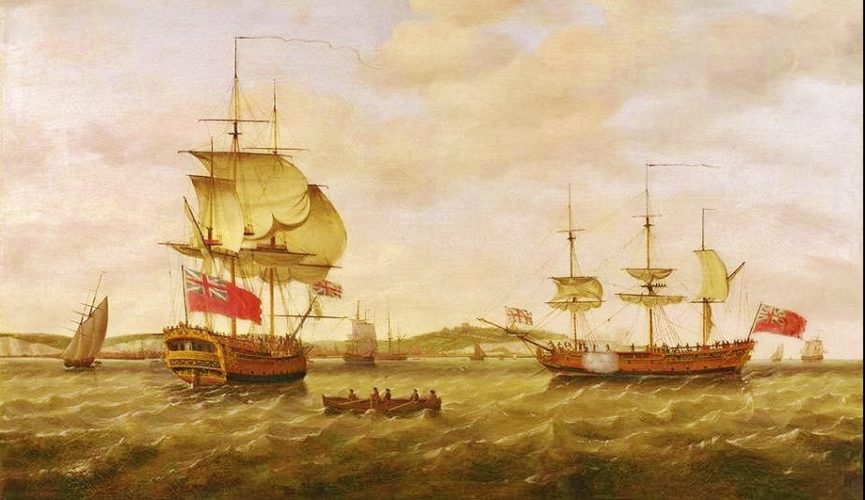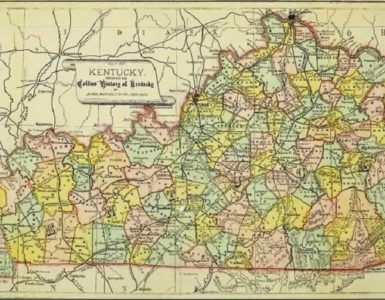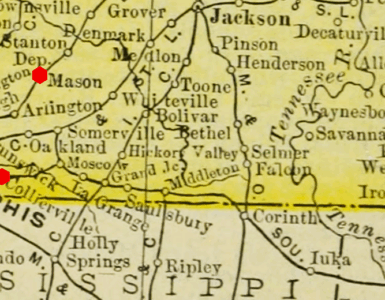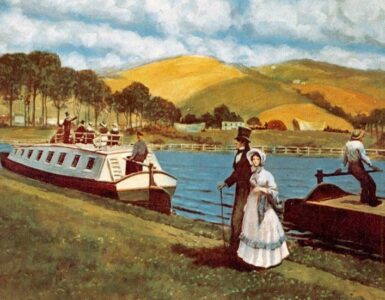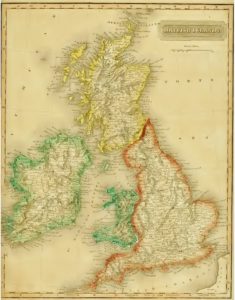 John Ross was born July 23, 1783 to John and Elizabeth (Corcoran) Ross who were Roman Catholics living in Dublin, Ireland. His parents died when he was very young leaving John an orphan. At the age of eighteen he left Ireland for a hopefully better life in England. On January 1, 1801 the Act of Union had tenuously brought together Great Britain and Ireland as the United Kingdom of Great Britain and Ireland, so possibly, Ross believed the new relationship with Britain meant better opportunities for an Irishman in England. The sailing trip from Dublin across the Irish Sea to Liverpool was about two hundred miles. Liverpool was growing rapidly due to increased trade created by the canal running from Liverpool to Gathurst which would eventually go all the way to Leeds. Where there is trade and transportation, there is often work whether it is related to shipping or supplying the necessities of life, so John Ross believed that Liverpool would offer a vocational opportunity. His hope was fulfilled when he was accepted by a cobbler to apprentice making shoes. During the time Ross was in Liverpool it was common practice for the British to impress men to serve in the Royal Navy. One of the issues that would contribute to starting the War of 1812 would be the Royal Navy boarding United States vessels and seizing crews for its ships of the line. As a strong young man from Ireland, John Ross was a prime candidate for the Royal Navy, so much so that his apprenticeship was interrupted and he was forced onto a ship three different times. He managed to escape and return to Liverpool the first two times, but by the third impressment Ross had finished learning how to make shoes and was ready to set up shop. Shrewdly, he used the ship he worked on during his last impressment as his ticket out of England. He jumped ship when it docked in Barbados and boarded a vessel bound for New London, Connecticut. He was hatless, broke, and shoeless, which was particularly unfortunate for a cobbler. With things not going very well, John Ross hoped to have a better life.
John Ross was born July 23, 1783 to John and Elizabeth (Corcoran) Ross who were Roman Catholics living in Dublin, Ireland. His parents died when he was very young leaving John an orphan. At the age of eighteen he left Ireland for a hopefully better life in England. On January 1, 1801 the Act of Union had tenuously brought together Great Britain and Ireland as the United Kingdom of Great Britain and Ireland, so possibly, Ross believed the new relationship with Britain meant better opportunities for an Irishman in England. The sailing trip from Dublin across the Irish Sea to Liverpool was about two hundred miles. Liverpool was growing rapidly due to increased trade created by the canal running from Liverpool to Gathurst which would eventually go all the way to Leeds. Where there is trade and transportation, there is often work whether it is related to shipping or supplying the necessities of life, so John Ross believed that Liverpool would offer a vocational opportunity. His hope was fulfilled when he was accepted by a cobbler to apprentice making shoes. During the time Ross was in Liverpool it was common practice for the British to impress men to serve in the Royal Navy. One of the issues that would contribute to starting the War of 1812 would be the Royal Navy boarding United States vessels and seizing crews for its ships of the line. As a strong young man from Ireland, John Ross was a prime candidate for the Royal Navy, so much so that his apprenticeship was interrupted and he was forced onto a ship three different times. He managed to escape and return to Liverpool the first two times, but by the third impressment Ross had finished learning how to make shoes and was ready to set up shop. Shrewdly, he used the ship he worked on during his last impressment as his ticket out of England. He jumped ship when it docked in Barbados and boarded a vessel bound for New London, Connecticut. He was hatless, broke, and shoeless, which was particularly unfortunate for a cobbler. With things not going very well, John Ross hoped to have a better life.
As he settled in Connecticut, Ross was made to feel at home by the kindness of some locals and he put his cobbling tools to use making shoes. At the time he immigrated there was not a Roman Catholic Church in New London, but he was befriended by some Christians—likely from a Congregational church, who told him of his need for Christ for redemption from sin. John embraced the gospel and shortly thereafter came to believe he was called to the ministry. The next step was formal education, but it would be a challenge because he continued to struggle financially. As would be the case for impoverished ministerial candidate Zelotes Holmes, Ross obtained funds for studies from a local women’s charity association. He attended Middlebury College in Vermont, which was established by Congregationalists, and then went on to study divinity at Princeton Seminary as a member of its second class. He completed the curriculum in 1816.
John’s plan was to go into missionary work in the western frontier of the nation, but the Presbyterian Church in the United States of America (PCUSA) missions committee had no funds to support him on the field, so he went to Philadelphia as a local missionary for about three months. To make his way to the desired field of ministry, Ross accepted a call in the Presbytery of Redstone to the Somerset Church which was about sixty-five miles southeast of Pittsburgh. He was ordained and installed December 3, 1817, by a Presbytery commission that included Francis Herron, James Graham, and Thomas Hunt. Shortly into this call he married Emma York of Stonington, Connecticut. After a short call in Somerset, the Ross household moved west to Ripley, Ohio, for John to serve a different congregation for about four years.
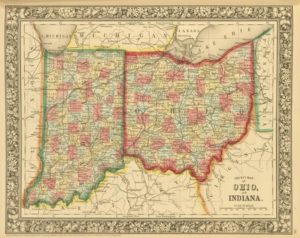 In 1822 the General Assembly appointed Ross to preach for three months in Fort Wayne, Indiana. The distance from Ripley to Fort Wayne is about two-hundred miles. Looking back on his experiences during the trip in a letter written in 1859, he described the difficulties encountered. Rev. Ross and Matthias Griggs, who was a trader taking hats and dried fruits to sell to settlers, set out in a two-horse wagon. The first night they stopped they were unsettled by the continued howling of wolves that surrounded their camp. As the journey wore on they went through a great snowstorm that reduced their speed as they pressed on through the cold muck. But the worst was yet to come because the temperature continued to drop freezing the muck and locking their wheels in place. They tried to strike a fire to melt the ice and keep on moving, but they could not get the tinder to ignite with a spark from flint (read Jack London’s, “To Light a Fire,” to understand the problem). They left their goods-laden wagon to their trusty dog as they unhitched the horses and went on to Fort Wayne. They could not ride their mounts because the wind was frigid, so they used the horses for wind breaks as they walked on the leeward side. They finally made it to Fort Wayne and were welcomed by Samuel Hanna, who would later become an elder in the Fort Wayne Church. Fort Wayne had about one-hundred-fifty residents and was ready for a church. Ross preached the next day and continued to do so for three months. He would travel to Fort Wayne four more times during his ministry. John Ross must have been a rugged and stout figure of a man well prepared for the difficulties of frontier missions by his experiences under servitude to Britain’s Royal Navy.
In 1822 the General Assembly appointed Ross to preach for three months in Fort Wayne, Indiana. The distance from Ripley to Fort Wayne is about two-hundred miles. Looking back on his experiences during the trip in a letter written in 1859, he described the difficulties encountered. Rev. Ross and Matthias Griggs, who was a trader taking hats and dried fruits to sell to settlers, set out in a two-horse wagon. The first night they stopped they were unsettled by the continued howling of wolves that surrounded their camp. As the journey wore on they went through a great snowstorm that reduced their speed as they pressed on through the cold muck. But the worst was yet to come because the temperature continued to drop freezing the muck and locking their wheels in place. They tried to strike a fire to melt the ice and keep on moving, but they could not get the tinder to ignite with a spark from flint (read Jack London’s, “To Light a Fire,” to understand the problem). They left their goods-laden wagon to their trusty dog as they unhitched the horses and went on to Fort Wayne. They could not ride their mounts because the wind was frigid, so they used the horses for wind breaks as they walked on the leeward side. They finally made it to Fort Wayne and were welcomed by Samuel Hanna, who would later become an elder in the Fort Wayne Church. Fort Wayne had about one-hundred-fifty residents and was ready for a church. Ross preached the next day and continued to do so for three months. He would travel to Fort Wayne four more times during his ministry. John Ross must have been a rugged and stout figure of a man well prepared for the difficulties of frontier missions by his experiences under servitude to Britain’s Royal Navy.
Wagons could be troublesome, as Ross had learned, so unless one was absolutely necessary the preferred method of travel was on horseback. Saddle-weary Ross covered extensive areas of both western Ohio and eastern Indiana preaching in cabins and forts or any structure providing shelter. When he was forty years old he accepted a call to Beulah Church in Richmond, Indiana, so his household settled for an extended tenure of twenty-five years ending in 1849. From this point Ross’s ministry will be tracked from the account of his life in the Necrological Report published by Princeton Seminary.
From the printed Minutes of the General Assembly, it appears that in 1849 he was a member of the Presbytery of Muncie and continued to be a member until his death.… In 1849 he was Stated Supply at Burlington, Indiana, and in 1850 at Windsor, Ohio. After the latter year he is stated to be ”aged” and “infirm.” After leaving Richmond, Indiana, he resided successively near New Paris, Ohio; Milton, Connersville, Knightstown, Burlington, Muncie and Tipton, Indiana, most of the time with one or another of his children. He was one of the pioneers of the Presbyterian Church in Indiana. In labors he was abundant. As long as he could stand in the pulpit he was fond of preaching, and sometimes preached with considerable vigor long after he had passed his eightieth year.
He lived to be one of the oldest, if not the oldest minister in the Presbyterian Church of his day and was for several years preceding his death the oldest living alumnus of Princeton Seminary and the only survivor of its second class. He died in the home of one of his daughters in Tipton, Indiana, March 11, 1876. Emma had predeceased him April 9, 1855. John and Emma had nine children—John Henry, Harriet, Ann, Emma, Peter, Edward, Recca, Oliver, and William. His life had been a challenging one on the frontier, but he was remembered in his day as “Father Ross” because of his ministry to remote congregations in the land of Hoosiers and his importance to Indiana Presbyterianism. No publications by Ross could be located and it appears from the sources available that he did not attend the annual meetings of the PCUSA General Assembly.
Barry Waugh
Notes–See, “John McElhenney, Mountaineer Minister,” for another missionary to a developing area of the United States in West Virginia. The Princeton Seminary Necrological Report for 1877 was the main source. The sea scene in the header and the map of Ohio and Indiana are from Wikimedia Commons. Helpful books include: History of the Presbytery of Redstone Organized by the Synod of New York and Philadelphia, Sept. 19, 1781, and Under its Care till 1788; A Part of the Synod of Virginia, 1788-1802 of the Synod of Pittsburg, 1801-1881; and Now of the Synod of Pennsylvania, 1881-1889, published by a committee of presbytery including John M. Barnett, John C. Meloy, and Ebenezer Finley, 1889; Historical Sketch of the First Presbyterian Church, Fort Wayne, Indiana. With Early Reminiscences of the Place. A Lecture Before the Congregation, March 7, 1860 by J. L. Williams; Contributions to the Early History of the Presbyterian Church in Indiana Together with Biographical Notices of the Pioneer Ministers, Hanford A. Edson, 1898. The entry for John Ross on Karen Williams’s Family Tree on Geneanet is informative and well documented. Buckeye Presbyterianism: An Account of the Seven Presbyterian Denominations with their Twenty-One Synods and More than Sixty Presbyteries which at One Time or Another have Functioned Wholly or in Large Part Within the State of Ohio, by a committee of the United Presbyterian Synod of Ohio, 1968; Hoosier Zion: The Presbyterians in Early Indiana, by L. C. Rudolph, 1963. McClintock and Strong’s Cyclopedia of Biblical, Theological, and Ecclesiastical Literature, vol. 9, has an entry for Ross, but as is often the case, the information appears to have been borrowed, in this case from the PTS Necrological Report.


